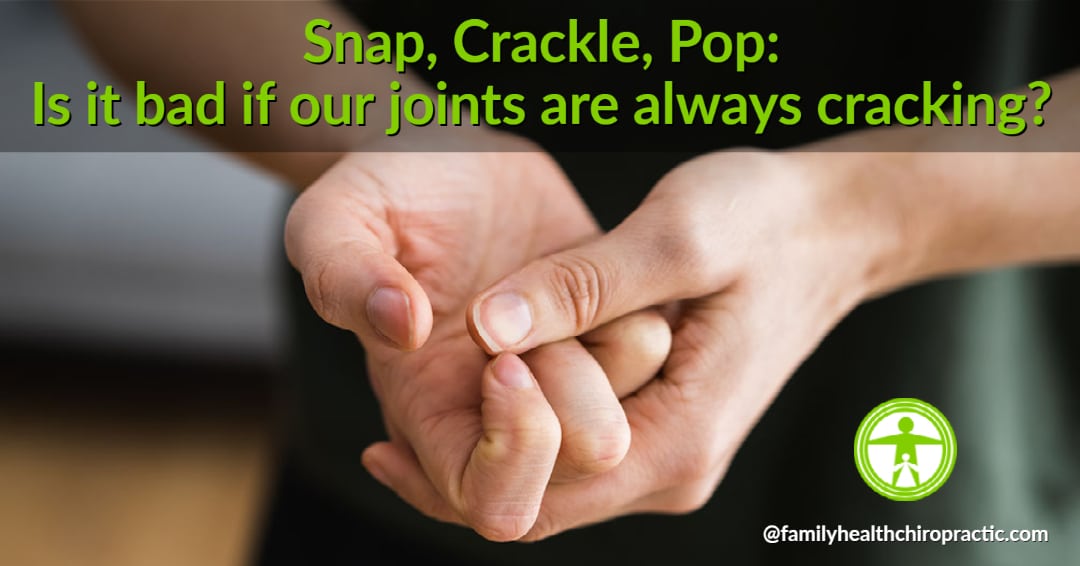A big concern that patients share with me is the amount of snapping, cracking and popping their joints make throughout the day.
There are many times when a patient will share that they don't want to exercise or perform certain movements such as squatting and lunging or reaching overhead, simply because of the amount of noise their joints make.
While it can be concerning, the reality is – most cracking and snapping is innocuous and has nothing to do with causing or developing arthritis or degeneration.
It's well understood that the majority of sounds we hear from joints are simply the compression of air bubbles moving within the space of our joints.
Other sounds are caused by calcium deposits embedded within tendons sliding over bones in a joint. And as long as there is no pain during the actual snapping, cracking or popping, it's nothing to be concerned with.
In this article, I'll share some of the common causes of “noisy joints” and what it could possibly mean for joint health.
Why Do Our Joints Pop? (Crepitus)
In orthopedic and chiropractic medical circles, crepitus is the word used to describe the popping, clicking or crackling sound in a joint.
Joint popping occurs from nitrogen gas moving in the joint as is usually harmless.
People most often notice crepitus in their knees, but it can also happen in other joints like the shoulder, elbow or neck.
Crepitus with pain, heat or swelling can be a sign of wear and tear or injury. So if crepitus is ever painful, you should consult a doctor or get checked.
While most crepitus is harmless, some forms of crepitus signal a problem. If the popping or crunching sound comes with pain, you should see a doctor to evaluate the cause.
The possible causes of painful joint popping may include:
- Osteoarthritis: a type of arthritic condition in which abnormal movement, lack of movement or trauma results in cartilage and joint structures wearing down, leaving bones unprotected and creating inflammation. When bones rub and grind, it causes pain and stiffness that usually gets worse with activity. Read more about arthritis.
- Patellofemoral pain syndrome (PFS): Also known as runner’s knee, PFS causes crepitus along with pain behind the kneecap (patella). It can happen when you suddenly increase your activity level and is often caused by running, squatting or jumping. Learn more about knee pain.
- Torn cartilage: A cartilage tear can happen because of a sports injury, a fall or an accident. Cartilage damage is another possible cause of painful crepitus. One of the best ways to support cartilage is with high quality collagen peptides.
What Can You Do About Noisy Joints?
As I said, most cracking, snapping and popping is harmless.
And as I also like to say, “Motion is Lotion for the joints.” So only move the joints you want to keep.
The more you move, the more your joints will lubricate themselves to diminish crackling.
Longitudinal studies have debunked any fears of arthritis developing from crackling joints (including cracking your knuckles), so you can put those fears to rest. But that crackling may be telling you that you need to move more.
For example… if knees are ‘creaky', consider Air Squats or Side Lunges.
If your hips are always popping, try a piriformis stretch, hip-flexor, hamstring and adductor stretch.
For snapping shoulders, incorporate windmill movements, arm swings and side bending with arms outstretched.
Additional Diagnostics and Treatments if You're Concerned
If you're experiencing crepitus with pain, swelling or discomfort, or you're still simply freaked out about it, consider having a in depth orthopedic/medical exam.
We can perform a physical examination of the joint(s) in question including additional testing such as:
- X-ray
- MRI scan
- CT scan
- Blood tests – a sample of your blood will be analyzed for signs of infection and inflammation
- Antibody tests – to see if autoimmune conditions such as rheumatoid arthritis could be causing your symptoms



